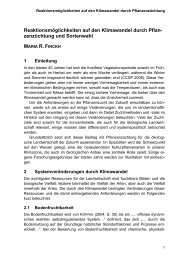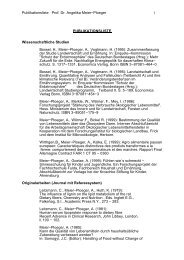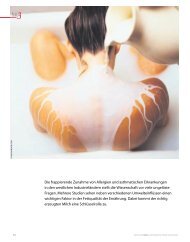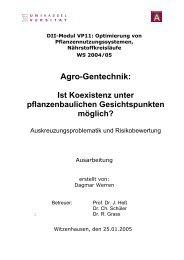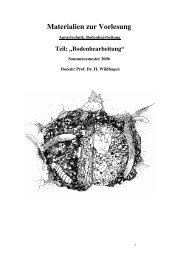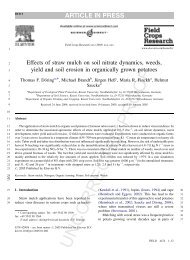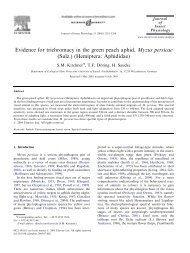You also want an ePaper? Increase the reach of your titles
YUMPU automatically turns print PDFs into web optimized ePapers that Google loves.
individual being)<br />
and the context of<br />
the animal (= the<br />
herd and the<br />
farming system)<br />
are the central<br />
focus:<br />
- ecological<br />
coherence<br />
- thinking in<br />
processes<br />
- support of selfregulation<br />
- system oriented<br />
Integrity<br />
approach:<br />
The animal’s<br />
integrity is the<br />
main focus:<br />
- life has its own<br />
specific<br />
dimensions;<br />
- respecting the<br />
integrity (entity)<br />
- explicit role of the<br />
human being<br />
- man and nature<br />
create something<br />
additional<br />
- oriented on the<br />
identity<br />
- animal and environment.<br />
2. Breeding is focused on the selection of animals<br />
that fit in a regional, land related farming situation.<br />
3. As a result of <strong>breeding</strong> the individual animal<br />
should be in balance.<br />
4. Breeding is based on quantitative animal models,<br />
which include additional values for an efficient<br />
animal production.<br />
1. Breeding is the eliciting of animal characteristics<br />
with the respect for and the insight into the species,<br />
the breed and the individual animal:<br />
- insight in the animal type<br />
- insight in the role of the animal into the system as a<br />
whole.<br />
Through this focus the specific value on its own of<br />
each breed will be strengthened in a specific cultural<br />
environment.<br />
2. Breeding is based on the personal insights of the<br />
breeder about the animal needs and the environment<br />
he provides them, and the adaptation to the farm<br />
circumstances.<br />
3. Genes are seen as the inner preconditions for the<br />
development of organisms; not the genes are creating<br />
features, but the animal species do so according to<br />
the inner preconditions of the genes and the outer<br />
preconditions of the environment. Cytoplasmatic<br />
hereditary has to be taken in account.<br />
4. The limits of <strong>breeding</strong> and the <strong>breeding</strong> goals are<br />
affected by the consciousness of the animal’s<br />
integrity.<br />
5. Optimising environment for an animal species is a<br />
way of <strong>breeding</strong>: it opens the possibility for the<br />
animal species to show it’s whole integrity in the<br />
single organism.<br />
5<br />
3. Harmony of built and shape:<br />
for instance Weeks’ Triple aAasystem;<br />
Selinger and Dekker:<br />
the golden section as a harmony<br />
imagination.<br />
4. Refusal of GMO, because of<br />
side effects for the animal itself<br />
(health, welfare) and the<br />
environment<br />
5. Searching for suitable,<br />
regional breeds for specific<br />
styles of organic farming<br />
(importance of genotype x<br />
environment interaction)<br />
1. Dutch Frisian breeders: kin<br />
<strong>breeding</strong> and on-farm<br />
development of lines.<br />
2. Specific meaning of the<br />
species within the mammal<br />
kingdom (Schad) in relation to<br />
its specific characteristics<br />
(Spengler)<br />
3. Ideal imagination of the cow:<br />
f.i. the cow with a highly<br />
specialised digestion- and<br />
metabolic system to transform<br />
roughage and highly<br />
differentiated limbs: a walking<br />
animal and sex dimorphism<br />
(Bakels)<br />
4. A personal and inner<br />
imagination of the animal:<br />
Endendijk’s imagination of the<br />
ideal cow.<br />
5. Refusal of GMO because the<br />
natural mating is taken from the<br />
animal; the technique is forcing<br />
the matter and crosses natural<br />
boarders of species.<br />
6. The natural way of mating<br />
cannot be taken from the animal.<br />
3. The elements of bio-dynamic animal <strong>breeding</strong><br />
Ideas about bio-dynamic <strong>breeding</strong> have been explicitly formulated by Spengler (1997) and<br />
can be derived from Baars and Nauta (2001; 2002). As a more general statement about<br />
organic animal <strong>breeding</strong>, Baars and Nauta (2001; 2002) formulated that <strong>breeding</strong> in organic<br />
farming should enlarge the race diversity, focus on the herd adaptation and respect the<br />
harmony of the animal build. Spengler (1997) stresses the relationship of the genome in<br />
relation to the (spiritual) being and the role of the environment.



